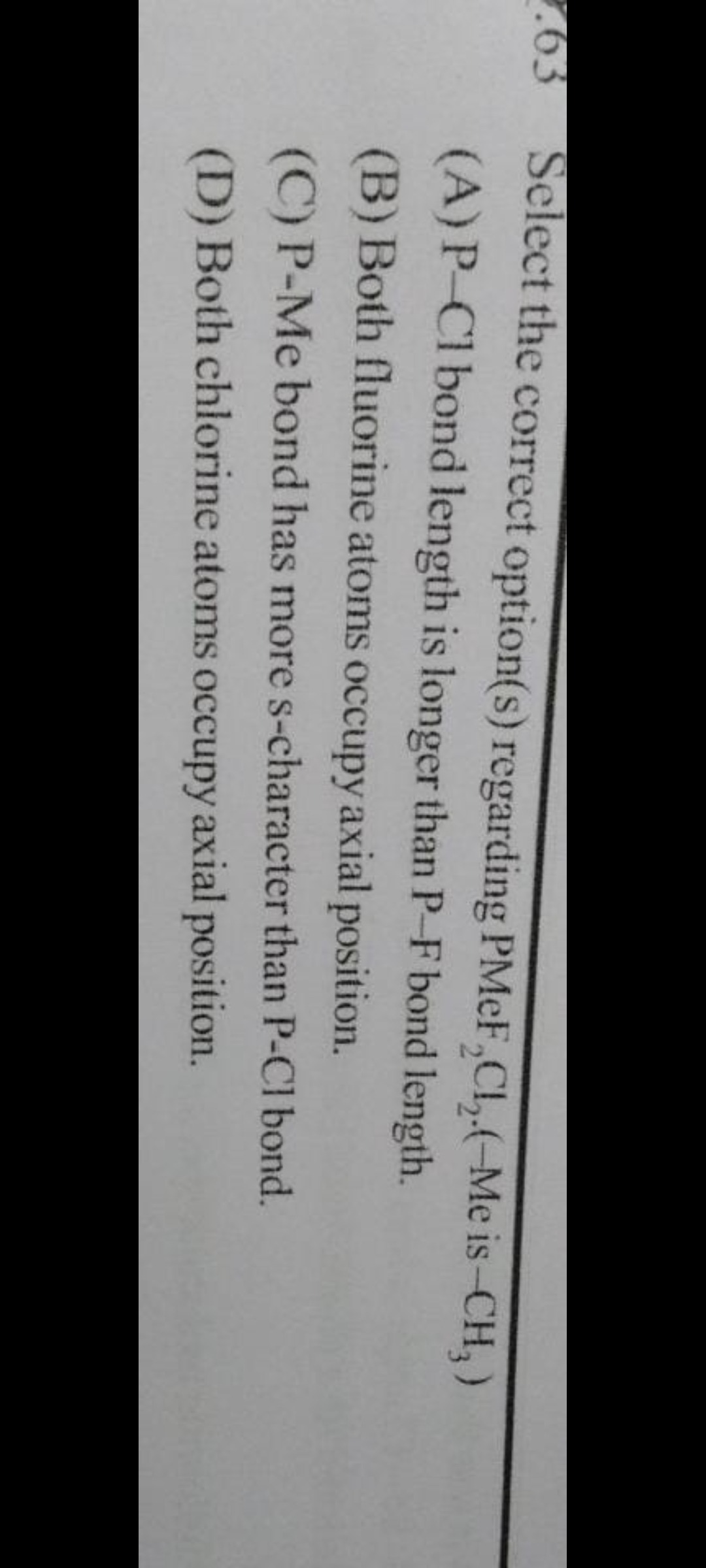Question
Question: Select the correct option(s) regarding $PMeF_2Cl_2$.(-Me is -$CH_3$)...
Select the correct option(s) regarding PMeF2Cl2.(-Me is -CH3)

P-Cl bond length is longer than P-F bond length.
Both fluorine atoms occupy axial position.
P-Me bond has more s-character than P-Cl bond.
Both chlorine atoms occupy axial position.
(A), (B), (C)
Solution
The molecule is PMeF2Cl2. Phosphorus is the central atom, bonded to one methyl group (-Me), two fluorine atoms (F), and two chlorine atoms (Cl). The total number of ligands is 5, so the electron geometry around phosphorus is trigonal bipyramidal.
In a trigonal bipyramidal geometry, there are two axial positions and three equatorial positions. According to Bent's Rule and the concept of apicophilicity, more electronegative substituents prefer to occupy axial positions, while less electronegative substituents, bulky groups, and groups that donate electron density into the bonding region (like groups forming bonds with more s-character) prefer equatorial positions. The order of apicophilicity (tendency to occupy axial positions) is generally F > Cl > Br > I > CN > OR > OAr > NR2 > NAr2 > Me > Ph > H.
In PMeF2Cl2, the ligands are F, Cl, and Me.
Electronegativity order: F > Cl > C (in Me).
Apicophilicity order: F > Cl > Me.
We have two axial positions and three equatorial positions.
The two most apicophilic ligands are the two F atoms. They will preferentially occupy the two axial positions.
The remaining ligands are the two Cl atoms and the one Me group. These will occupy the three equatorial positions.
So, the structure of PMeF2Cl2 has the two fluorine atoms in axial positions, and the two chlorine atoms and the methyl group in equatorial positions.
Let's evaluate the given options based on this structure:
(A) P-Cl bond length is longer than P-F bond length.
The P-Cl bonds are equatorial, and the P-F bonds are axial.
In a trigonal bipyramid, axial bonds are generally longer than equatorial bonds due to increased p-character in the hybrid orbitals forming the axial bonds and increased repulsion from equatorial ligands. So, P-F (axial) bond length is expected to be longer than P-F (equatorial) bond length, and P-Cl (axial) bond length is expected to be longer than P-Cl (equatorial) bond length.
However, we are comparing P-Cl bond length with P-F bond length. The intrinsic single bond lengths are approximately P-F ~ 156 pm and P-Cl ~ 204 pm. The difference in bond length due to axial vs equatorial position is typically smaller than the difference due to the identity of the bonded atoms.
For example, in PCl5, P-Cl (axial) ~ 214 pm, P-Cl (equatorial) ~ 202 pm. In PF5, P-F (axial) ~ 158 pm, P-F (equatorial) ~ 153 pm.
In PMeF2Cl2, we have P-F (axial) and P-Cl (equatorial).
Based on typical values, P-F (axial) ~ 158 pm and P-Cl (equatorial) ~ 202 pm.
Comparing these values, P-Cl bond length (~202 pm) is significantly longer than P-F bond length (~158 pm).
Therefore, option (A) is correct.
(B) Both fluorine atoms occupy axial position.
This is consistent with our structural prediction based on apicophilicity and Bent's rule. Fluorine is the most electronegative and most apicophilic ligand among F, Cl, and Me, and thus prefers the axial positions.
Therefore, option (B) is correct.
(C) P-Me bond has more s-character than P-Cl bond.
Both the P-Me bond and the P-Cl bonds are in the equatorial plane. The equatorial bonds are formed using hybrid orbitals with more s-character than the axial bonds.
According to Bent's Rule, hybrid orbitals with more s-character are directed towards less electronegative substituents.
In the equatorial plane, the ligands are Me and Cl. Electronegativity: Cl > C (in Me).
The P-Me bond is formed with the less electronegative methyl group, and the P-Cl bonds are formed with the more electronegative chlorine atoms.
Therefore, the hybrid orbital used by phosphorus to form the P-Me bond will have more s-character than the hybrid orbitals used to form the P-Cl bonds in the equatorial plane.
Thus, option (C) is correct.
(D) Both chlorine atoms occupy axial position.
This contradicts our structural prediction where both F atoms occupy axial positions because F is more apicophilic than Cl. The Cl atoms occupy equatorial positions.
Therefore, option (D) is incorrect.
Based on the analysis, options (A), (B), and (C) are correct.
